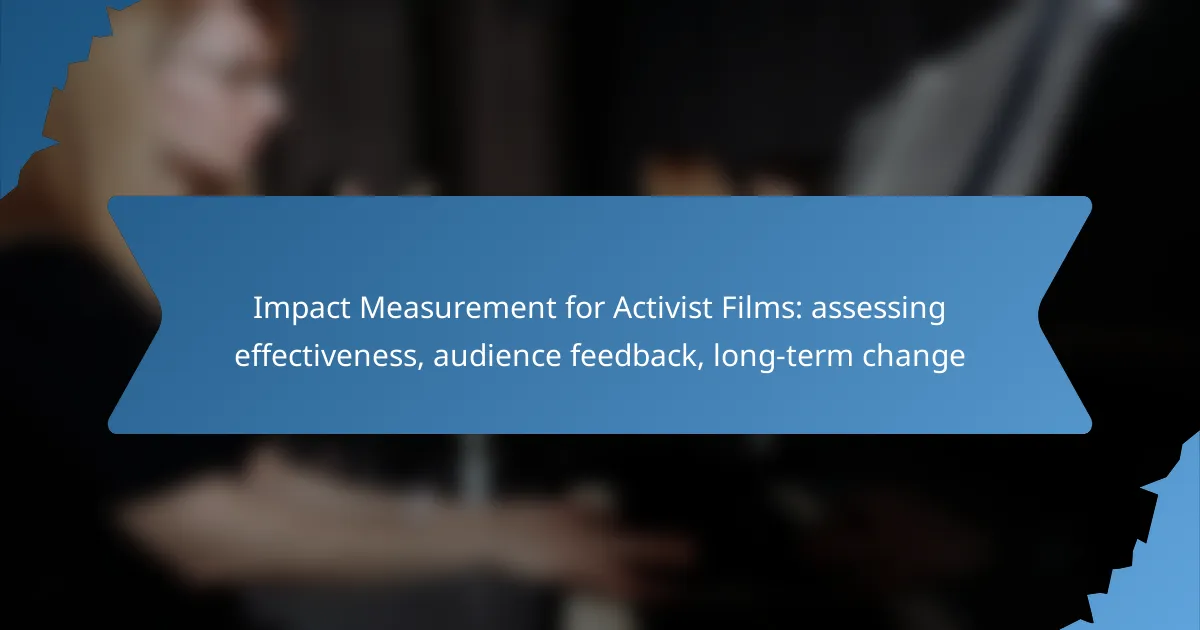Impact measurement for activist films is essential in understanding their effectiveness and the changes they inspire in audiences. By utilizing a blend of quantitative metrics and qualitative assessments, filmmakers can gather valuable feedback and insights that inform future projects. These films not only engage viewers but also have the potential to drive long-term societal change by influencing public opinion and encouraging community involvement.

How can activist films measure their impact in the UK?
Activist films in the UK can measure their impact through a combination of quantitative metrics, qualitative assessments, and case studies. These methods help filmmakers understand audience engagement, feedback, and the long-term changes their films may inspire.
Quantitative metrics
Quantitative metrics involve collecting numerical data to evaluate the effectiveness of activist films. Key metrics include viewership numbers, social media engagement rates, and ticket sales. For instance, tracking the number of screenings and audience turnout can provide insights into the film’s reach.
Additionally, surveys can be distributed to viewers before and after screenings to gauge changes in attitudes or awareness. Metrics like these can help filmmakers assess the immediate impact of their work on public perception and behavior.
Qualitative assessments
Qualitative assessments focus on gathering in-depth feedback from audiences to understand their emotional and intellectual responses to activist films. This can include interviews, focus groups, or open-ended survey questions that allow viewers to express their thoughts and feelings in detail.
Filmmakers should look for themes in audience feedback, such as shifts in perspective or personal stories that illustrate the film’s impact. This qualitative data can complement quantitative metrics, providing a fuller picture of the film’s effectiveness.
Case studies
Case studies of successful activist films can serve as valuable examples for measuring impact. By analyzing specific films that have led to measurable social change, filmmakers can identify strategies that worked well. For instance, a film that successfully mobilized community action can provide insights into effective outreach and engagement techniques.
Documenting the outcomes of these films, such as policy changes or increased activism, can help establish best practices for future projects. Filmmakers should consider compiling a portfolio of case studies to showcase their impact and inform their approach to future activism through film.

What feedback mechanisms are effective for activist films?
Effective feedback mechanisms for activist films include audience surveys and social media engagement. These tools help filmmakers gauge viewer reactions, understand impact, and refine future projects based on audience insights.
Audience surveys
Audience surveys are a direct way to collect feedback from viewers after they watch an activist film. These surveys can include questions about emotional responses, perceived messages, and calls to action. Consider using a mix of multiple-choice and open-ended questions to capture both quantitative and qualitative data.
To maximize response rates, keep surveys concise and offer incentives, such as a chance to win a gift card or exclusive content. Aim for a response rate of at least 20-30% to ensure the data is representative of your audience.
Social media engagement
Social media engagement allows filmmakers to interact with their audience in real-time, providing immediate feedback on their films. Platforms like Twitter, Instagram, and Facebook can be used to create polls, share clips, and encourage discussions about key themes and messages. Monitoring comments and shares can also reveal how well the film resonates with viewers.
To enhance engagement, consider using hashtags relevant to the film’s themes and encourage viewers to share their thoughts. Track metrics such as likes, shares, and comments to assess overall audience sentiment and identify areas for improvement in future projects.

What are the long-term changes driven by activist films?
Activist films can lead to significant long-term changes by influencing public opinion, shaping policies, and fostering community involvement. These films often serve as catalysts for social movements, prompting viewers to take action and engage with critical issues.
Policy shifts
Activist films frequently inspire policy shifts by raising awareness about specific issues and mobilizing public support. For example, documentaries addressing climate change have led to increased advocacy for environmental regulations and renewable energy initiatives. Filmmakers should aim to present clear, actionable solutions alongside compelling narratives to maximize impact.
To effectively drive policy change, filmmakers can collaborate with advocacy groups and policymakers to ensure their messages align with ongoing legislative efforts. Engaging audiences through screenings and discussions can further amplify the call for change, making it essential to track viewer responses and feedback.
Community engagement
Community engagement is another vital long-term change driven by activist films, as they often encourage viewers to participate in local initiatives and social movements. By showcasing grassroots efforts and personal stories, these films can foster a sense of connection and urgency among audiences. For instance, films highlighting local social justice issues can galvanize community members to organize events or volunteer for related causes.
To enhance community involvement, filmmakers should consider hosting interactive screenings that include Q&A sessions or workshops. This approach not only deepens the audience’s understanding but also empowers them to take tangible steps toward change. Monitoring engagement levels and gathering feedback can help filmmakers refine their strategies for future projects.

How do activist films influence public opinion?
Activist films shape public opinion by raising awareness about social issues and inspiring viewers to take action. Through compelling narratives and emotional engagement, these films can shift perceptions and motivate societal change.
Documentary storytelling
Documentary storytelling is a powerful tool in activist films, as it presents real-life events and personal experiences that resonate with audiences. By showcasing authentic narratives, these films can evoke empathy and encourage viewers to connect with the issues presented.
Effective documentary storytelling often includes a clear structure, focusing on a central theme or message. Filmmakers should consider using interviews, archival footage, and on-the-ground reporting to create a compelling narrative that captivates viewers and drives home the urgency of the cause.
Celebrity endorsements
Celebrity endorsements can significantly enhance the reach and impact of activist films. When well-known figures support a cause, they can attract larger audiences and lend credibility to the message being conveyed. This can lead to increased awareness and engagement with the issues at hand.
However, it is crucial to ensure that celebrity endorsements align authentically with the film’s message. Audiences are often skeptical of endorsements that appear disingenuous, so filmmakers should choose advocates who genuinely care about the cause and can articulate its importance effectively.

What frameworks exist for evaluating film effectiveness?
Several frameworks can help assess the effectiveness of activist films, focusing on their impact on audiences and societal change. Commonly used models include logic models and theories of change, which provide structured approaches to measure outcomes and influence.
Logic models
Logic models are visual representations that outline the relationship between resources, activities, outputs, and outcomes of a film project. They help filmmakers clarify their goals and the pathways to achieving them, making it easier to evaluate effectiveness.
When creating a logic model, start by identifying the inputs (such as funding and talent), the activities (like production and distribution), and the expected outputs (viewership numbers or engagement metrics). Then, define short-term, intermediate, and long-term outcomes, such as increased awareness or policy changes.
Common pitfalls include overly ambitious outcomes or neglecting to link activities directly to measurable results. Regularly revisiting and updating the logic model can enhance its relevance and accuracy.
Theory of change
Theory of change is a comprehensive framework that outlines how and why a desired change is expected to happen in a specific context. It emphasizes the causal pathways that connect activities to outcomes, allowing filmmakers to articulate their vision clearly.
To develop a theory of change, start by defining the ultimate goal of the film. Then, work backward to identify the necessary preconditions and interventions that will lead to that goal. This process often involves stakeholder engagement to ensure that the theory reflects diverse perspectives.
Be cautious of assumptions that may not hold true in practice. Testing the theory through pilot screenings or audience feedback can provide valuable insights and help refine the approach for greater impact.

Which organizations specialize in impact measurement for films?
Several organizations focus on impact measurement for films, helping filmmakers assess the effectiveness of their work in driving social change. These organizations provide tools, frameworks, and expertise to evaluate audience engagement and long-term outcomes.
Impact Partners
Impact Partners is a consultancy that specializes in measuring the social impact of films. They work closely with filmmakers to develop tailored impact strategies that align with the film’s goals and target audience. Their approach often includes pre-release planning and post-release evaluation to track audience response and behavioral changes.
They utilize a variety of methods, including surveys, focus groups, and social media analytics, to gather feedback and assess the effectiveness of the film in sparking conversations and actions. Filmmakers can benefit from their expertise in identifying key performance indicators (KPIs) that matter most for their specific projects.
Doc Society
Doc Society is an organization dedicated to supporting documentary filmmakers and measuring their impact. They provide resources and guidance on how to create effective impact campaigns that resonate with audiences. Their focus is on fostering community engagement and facilitating discussions around important social issues highlighted in documentaries.
Through initiatives like the Impact Field Guide, Doc Society offers filmmakers practical tools to design and implement impact assessments. They emphasize the importance of storytelling in driving change and encourage filmmakers to track both qualitative and quantitative outcomes to understand their film’s influence over time.

What role does audience feedback play in shaping future films?
Audience feedback is crucial for shaping future activist films as it provides insights into viewer perceptions, emotional responses, and engagement levels. This feedback helps filmmakers understand what resonates with their audience and what changes might enhance the film’s impact.
Understanding audience perceptions
Audience perceptions can be gauged through surveys, focus groups, and online reviews. These methods reveal how viewers interpret themes, characters, and messages in the film. Filmmakers should prioritize collecting qualitative feedback to capture the nuances of audience reactions.
Incorporating feedback into future projects
Incorporating audience feedback involves analyzing the data collected and identifying common themes or suggestions. Filmmakers can use this information to adjust storytelling techniques, refine messaging, or enhance visual elements in their next projects. For example, if viewers express a desire for more character development, future films can focus on deeper character arcs.
Measuring long-term impact
Measuring the long-term impact of activist films requires tracking changes in audience attitudes or behaviors over time. This can be done through follow-up surveys or social media monitoring. Filmmakers should aim to establish metrics that reflect shifts in public opinion or increased activism related to the film’s subject matter.
